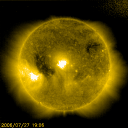www.ciesin.org/datasets/gpw/globldem.doc.html
Summary
Demographic information is usually provided on a national basis. But we know that countries are ephemeral phenomena. As an alternate scheme one might use ecological zones rather than nation states. But there is no agreement as to what these zones should be. By way of contrast global environmental studies using satellites as collection devices yield results indexed by latitude and longitude. Thus it makes sense to assemble the terrestrial arrangement of people in a compatible manner. This alternative is explored here, using latitude/longitude quadrilaterals as bins for population information
You can get the actual data, or look at the maps with population densities superimposed: The World in GPW

Dataset Variables
There are four files in this dataset - population counts (i.e., the number of people in each cell), population density (i.e., people per square kilometer), global population (counts, smoothed), global population (population density, smoothed.
The data are available as ASCII files or as pkzip compressed ArcInfo Export files
Each format is available as a global coverage, or as one of five subsets: North and Central America, Latin America and the Caribbean, Africa and Europe, Asia, and Australia, New Zealand, and Oceania
Archival and Access Information
GPW v1 is archived and distributed by the Socioeconomic Data and Applications Center (SEDAC) and is available via ftp at www.ciesin.columbia.edu/datasets/ gpw/ftpgrid.html. More recent versions of GPW are available at sedac.ciesin.columbia.edu/gpw.
Do-It-Yourself Mapping
www.gpsvisualizer.com
GPS Visualizer is a free, easy-to-use online utility that creates maps and profiles from GPS data (tracks and waypoints), street addresses, or simple coordinates. Use it to see where you've been, plan where you're going, or visualize geographic data (business locations, events, customers, real estate, etc.).
GPS Visualizer can draw maps in JPEG and PNG format in addition to SVG. These bitmapped graphics aren't nearly as versatile, but they don't require a plug-in
Geotagging on Flickr
flickr.com/photos/steeev/27164700
A snapshot taken on 11-Jul-05 of the locations at which 30222 geotagged flickr images were taken.
Trompe l'pedestrian
rense.com/general67/street.htmJulian Beever is an English artist who works on the pavements of England, France, Germany, USA, Australia and Belgium. Its peculiarity? Beever gives his drawings an anamorphic view; his images are drawn in a way which gives them a strong illusion of three dimensionality when viewed from the correct angle.
A famous 'Old Master' using the anamorphic method is Hans Holbein's The Ambassadors — Jean de Dinteville and Georges de Selves — (1533), at the National Gallery in London
plus.maths.org/issue33/ features/dartnell_art — see this Zipped PowerPoint presentation ( www.virtualartroom.com/ presentations/ Anamorphosis.zip ) from an educational site www.virtualartroom.com/ interactive_exercises.htm. This ( www.constant.irisnet.be/ ~peter_w/ log/ index.php?p=20 ) talks about it too. The page is a bit wonky, but it does have a good picture of the anamorphic section of the painting as it looks at the 'right' angle, which is fairly rare.






No comments:
Post a Comment